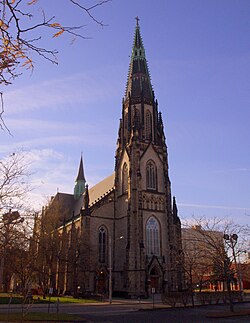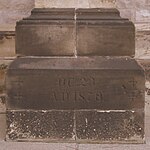St. Joseph Oratory
St. Joseph Roman Catholic Church | |
 | |
| Location | 1828 Jay Street Detroit, Michigan |
|---|---|
| Built | 1870-1873 |
| Architect | Francis G. Himpler; Donaldson and Meier |
| Architectural style | Late Gothic Revival; German Hall Church |
| NRHP reference No. | 72000670, 91002013[1] |
| Added to NRHP | December 08, 1972, January 28, 1992 |
Saint Joseph Roman Catholic Church, founded in 1855, is a historic German Catholic parish with a landmark church located at 1828 Jay Street in the Eastern Market - Lafayette Park neighborhood area just outside downtown Detroit, on the city's central east side. The building is on the National Register of Historic Places and deemed 'of national importance' because of its stained glass.[2] It is one of three churches that make up Mother of Divine Mercy parish.
Architecture

The German-inspired Gothic structure had its cornerstone laid in 1870 and was dedicated in 1873, making it one of the oldest extant churches in Detroit. Francis G. Himpler, a Ottweiler(Germany)-born New York architect, designed the building which is considered one of the Midwest's best examples of Victorian Gothic architecture, especially so because the structure is effectively unaltered. The building is distinguished by its stained glass, notable in its intricate designs and wide usage. Also of note is the woodwork, statuary, and original high altar in the interior. St. Joseph's Church was placed on the National Register of Historic Places in 1972; the buildings in the surrounding complex were added in 1992. The church still operates today with two Masses every Sunday and Daily Mass on certain weekdays.
Traditional worship

St. Joseph Parish has continued traditional worship throughout its history, maintaining the Latin language, alongside vernacular German and English, in its Novus Ordo Masses after the Second Vatican Council. Many Masses are celebrated ad orientem, but a free-standing altar is available for priests who prefer it. In Fall 2007, after a 37-year absence, the parish reinstated the Latin Tridentine Mass which was widely replaced when the Catholic Church created the Novus Ordo Mass in 1969. St. Joseph joins the nearby parishes of St. Josaphat and Assumption Grotto as one of the few midwestern parishes offering the old Mass. St. Joseph offers it occasionally on some feast days, such as Christmas and St. Joseph's day. As a historically German parish, St. Joseph also offers German language Masses occasionally.
The parish is known for its musical heritage, offering orchestral Masses composed by the likes of Haydn, Mozart, Schubert, and lesser known composers on certain Sundays and Holy Days, and maintaining traditional choir and organ music.[citation needed] The St. Joseph tracker organ is a powerful instrument in a fine acoustical space. Originally built by J. H. & C. S. Odell for the present Church structure in 1873, the organ was greatly altered about 1910 and again in the early 1940s. Having declined into unplayability, it was replaced for the celebration of the church building's centennial in 1973 by the organ builder William M. Worden, using many of the Odell pipes. It currently contains twenty-nine stops. For greater general participation during the Latin Mass, St. Joseph Parish is one of the very few parishes probably in the entire United States to have available for use, even by the entire congregation, the Gregorian Missal published by the monks of Solesmes. The traditional Adoremus Hymnal published by Ignatius Press is also used at both the Latin and English Masses. Contemporary worship hymns are not used by the St. Joseph Music Ministry.
Current Status
On June 19, 2013 by a decree from his excellency Allen H. Vigneron, Archbishop of Detroit, the clustered parishes of St. Joseph, Sweetest Heart of Mary and St. Josaphat were merged to create the new Mother of Divine Mercy parish.[3]
Effective July 1, 2013, Fr. Gregory Tokarski was appointed the new pastor of Mother of Divine Mercy parish.
Gallery
-
Façade of the church
-
Portal
-
Cornerstone
-
Parish rectory house next door to the church
See also
References
- ^ "National Register Information System". National Register of Historic Places. National Park Service. April 15, 2008.
- ^ Hill, Eric J. and John Gallagher (2002). AIA Detroit: The American Institute of Architects Guide to Detroit Architecture. Wayne State University Press.
- ^ "Parish Website". Motherofdivinemercy.com. 2013-06-19. Retrieved 2013-12-27.
Further reading
- Godzak, Roman (2000). Archdiocese of Detroit (Images of America). Arcadia Publishing. ISBN 0738507970.
- Godzak, Roman (2004). Catholic Churches of Detroit (Images of America). Arcadia Publishing. ISBN 0738532355.
- Godzak, Roman (2000). Make Straight the Path: A 300 Year Pilgrimage Archdiocese of Detroit. Editions du Signe. ISBN 2746801450.
- Muller, Herman Joseph (1976). The University of Detroit 1877-1977: A Centennial History. University of Detroit. ASIN B0006CVJ4S.
- Tentler, Leslie Woodcock with foreword by Cardinal Edmund Szoka (1992). Seasons of Grace: A History of the Catholic Archdiocese of Detroit. Wayne State University Press. ISBN 0814321062.
- Tutag, Nola Huse with Lucy Hamilton (1988). Discovering Stained Glass in Detroit. Wayne State University Press. ISBN 0-8143-1875-4.
External links
- Churches in Detroit, Michigan
- German-American culture in Detroit, Michigan
- Churches in the Roman Catholic Archdiocese of Detroit
- Religious organizations established in 1855
- Roman Catholic churches completed in 1873
- 19th-century Roman Catholic church buildings
- Properties of religious function on the National Register of Historic Places in Michigan
- German-American history
- 1855 establishments in Michigan
- National Register of Historic Places in Detroit, Michigan








